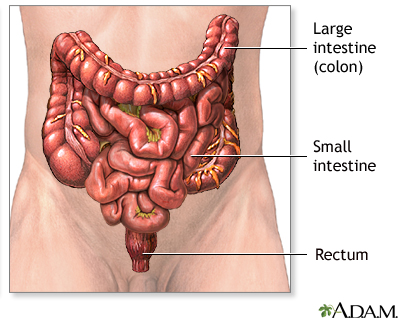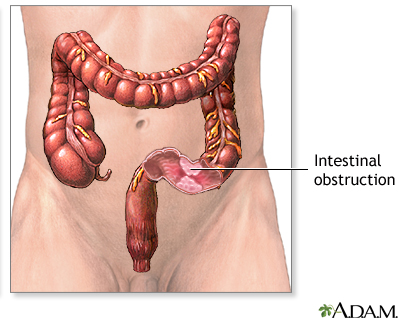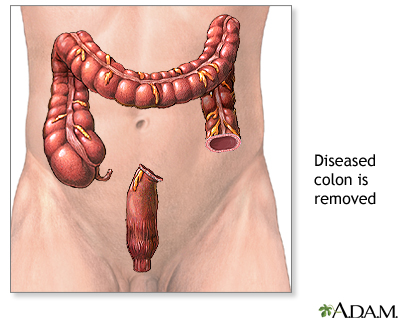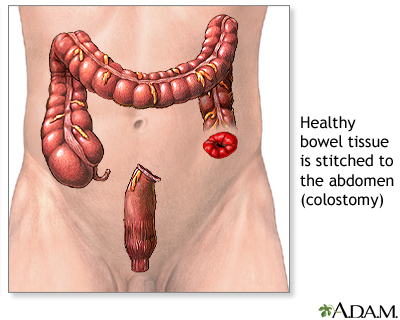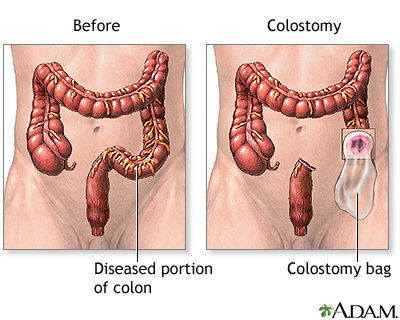Colostomy
Intestinal opening - stoma formation; Bowel surgery - colostomy creation; Colectomy - colostomy; Colon cancer - colostomy; Rectal cancer - colostomy; Diverticulitis - colostomyColostomy is a surgical procedure that brings one end of the large intestine out through an opening (stoma) made in the abdominal wall. Stools moving through the intestine drain through the stoma into a bag attached to the skin of the abdomen.
Description
The procedure is usually done after:
-
Bowel resection
Bowel resection
Large bowel resection is surgery to remove all or part of your large bowel. This surgery is also called colectomy. The large bowel is also called t...
 ImageRead Article Now Book Mark Article
ImageRead Article Now Book Mark Article - Injury to the bowel
The colostomy may be short-term or permanent.
Colostomy is done while you are under general anesthesia (asleep and pain-free). It may be done either with a large surgical cut in the abdomen or with a small camera and several small cuts (laparoscopy).
General anesthesia
General anesthesia is treatment with certain medicines that puts you into a deep sleep-like state so you do not feel pain during surgery. After you ...
The type of approach used depends on what other procedure needs to be done. The surgical cut is usually made in the middle of the abdomen. The bowel resection or repair is done as needed.
For the colostomy, one end of the healthy colon is brought out through an opening made in the abdomen wall, usually on the left side. The edges of bowel are stitched to the skin of opening. This opening is called a stoma. A bag called a stoma appliance is placed around the opening to allow stool to drain.
Your colostomy may be short-term. If you have surgery on part of your large intestine, a colostomy allows the other part of your intestine to rest while you recover. Once your body has fully recovered from the first surgery, you will have another surgery to reattach the ends of the large intestine. This is usually done after 12 weeks.
Why the Procedure Is Performed
Reasons a colostomy is done include:
- Infection of the abdomen, such as perforated diverticulitis or an abscess.
Diverticulitis
Diverticula are small, bulging sacs or pouches that form on the inner wall of the intestine. Diverticulitis occurs when these pouches become inflame...
 ImageRead Article Now Book Mark Article
ImageRead Article Now Book Mark ArticleAbscess
An abscess is a collection of pus in any part of the body. In most cases, the area around an abscess is swollen and inflamed.
 ImageRead Article Now Book Mark Article
ImageRead Article Now Book Mark Article - Injury to the colon or rectum (for example, a gunshot wound).
- Partial or complete blockage of the large bowel (intestinal obstruction).
-
Rectal or colon cancer.
Rectal or colon cancer
Colorectal cancer is cancer that starts in the large intestine (colon) or the rectum (end of the colon). It is also sometimes simply called colon ca...
 ImageRead Article Now Book Mark Article
ImageRead Article Now Book Mark Article - Wounds or fistulas in the perineum. This is the area between the anus and vulva (women) or the anus and scrotum (men).
Fistulas
A fistula is an abnormal connection between two body parts, such as an organ or blood vessel and another structure. Fistulas are usually the result ...
 ImageRead Article Now Book Mark Article
ImageRead Article Now Book Mark Article
Risks
Risks of anesthesia and surgery in general include:
- Reactions to medicines
- Breathing problems
- Bleeding, blood clots, infection
Risks of colostomy include:
- Bleeding inside your belly
- Damage to nearby organs
- Development of a hernia at the site of the surgical cut
Hernia
A hernia is a sac formed by the lining of the abdominal cavity (peritoneum). The sac comes through a hole or weak area in the strong layer of the be...
 ImageRead Article Now Book Mark Article
ImageRead Article Now Book Mark Article - Bowel protrudes through the stoma more than it should (prolapse of the colostomy)
- Narrowing or blockage of the colostomy opening (stoma)
- Scar tissue forming in the belly and causing intestinal blockage
- Skin irritation
- Wound breaking open
After the Procedure
You will be in the hospital for 3 to 7 days. You may have to stay longer if your colostomy was done as an emergency procedure.
You will be allowed to slowly go back to your normal diet:
- The same day as your surgery, you may be able to suck on ice chips to ease your thirst.
- By the next day, you will probably be allowed to drink clear liquids.
- Thicker fluids and then soft foods will be added as your bowels begin to work again. You may be eating normally within 2 days after surgery.
The colostomy drains stool (feces) from the colon into the colostomy bag. Colostomy stool is often softer and more liquid than stool that is passed normally. The texture of stool depends on which part of the intestine was used to form the colostomy.
Outlook (Prognosis)
Before you are released from the hospital, an ostomy nurse will teach you about diet and how to care for your colostomy.
References
Albers BJ, Lamon DJ. Colon repair/colostomy creation. In: Baggish MS, Karram MM, eds. Atlas of Pelvic Anatomy and Gynecologic Surgery. 5th ed. Philadelphia, PA: Elsevier; 2021:chap 96.
Galandiuk S, Netz U, Morpurgo E, et al. Colon and rectum. In: Townsend CM Jr, Beauchamp RD, Evers BM, Mattox KL, eds. Sabiston Textbook of Surgery. 21st ed. St Louis, MO: Elsevier; 2022:chap 52.
Russ AJ, Delaney CP. Rectal prolapse. In: Fazio the Late VW, Church JM, Delaney CP, Kiran RP, eds. Current Therapy in Colon and Rectal Surgery. 3rd ed. Philadelphia, PA: Elsevier; 2017:chap 22.
Review Date: 3/31/2024
Reviewed By: Debra G. Wechter, MD, FACS, General Surgery Practice Specializing in Breast Cancer, Virginia Mason Medical Center, Seattle, WA. Also reviewed by David C. Dugdale, MD, Medical Director, Brenda Conaway, Editorial Director, and the A.D.A.M. Editorial team.


